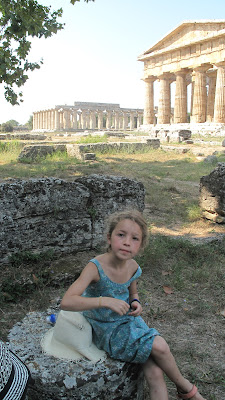 |
| Two temples to Hera at Paestum and one beautiful Persephone |
About 2500 years ago, it was a thriving mercantile centre, called Poseidonia after the god of the sea. It was an outpost of greater Greece. Later it was absorbed into the Roman Empire. For a thousand years or so it was hidden by malarial swamp.
 Eighteenth century travellers, steeped in knowledge of the classics, assigned gods to the temples: this was Posiedon's and that was Ceres'. But 20th century archaeologists have found hundreds of votive figurines which show that of the three main temples, two belong to the mother goddess Hera, and one is devoted to Athena, the goddess of wisdom.
Eighteenth century travellers, steeped in knowledge of the classics, assigned gods to the temples: this was Posiedon's and that was Ceres'. But 20th century archaeologists have found hundreds of votive figurines which show that of the three main temples, two belong to the mother goddess Hera, and one is devoted to Athena, the goddess of wisdom.The figurines they found at Hera's temple looked like this. Familiar, eh?! Here is Hera suckling a baby. She doesn't look anything like the bad mummy who threw her baby Hephaestus away because he was a cripple. She looks quite content, indeed she looks like the mother goddess we know so well, Mary.
 |
| Madonna del Granato in her sanctuary |
 |
| Two votive figurines from Paestrum |
pomegranate, the fruit that was associated with her. Pomegranates grow in some profusion in this part of Italy. In August, when I visited, the fruit are small and green, but already they are distinctive, exotically beautiful like jewellery, with the spiky tops that some historians say influenced the shape of real crowns. The fruit is like a fruit womb with its soft thick walls protecting the baby seeds.
What's interesting is how this image of Hera transmutes so easily to this one of the Madonna, who was often portrayed holding a pomegranate too – or holding a baby holding a pomegranate. And then into this one of the Queen holding her orb.
One of Mary's titles is Queen of Heaven, and clearly temporal queens were thought to be acting out a divine role.
 |
| Detail of the Madonna of the Pomegranates by Sandro Botticelli |
To the Romans, she was Juno consort of Jupiter, the captain of the gods of Olympus. But she was also the patroness of the Roman state, surely a pretty important role. She was the goddess of marriage and fertility, key concepts for any community. So why, when it came to naming the planets, did Juno – one of the three chief gods of the Romans – not get one?
I wondered about this as I looked up at that huge temple in Paestum. How come astrology – both traditional and even more so, modern, left out the goddesses, who were so equally represented in the temples and homes of the classical world? And indeed wielded as much power as their husbands, brothers and sons on Olympus?
We have the asteroid Juno now – a small rock in the belt between Mars and Jupiter. And this does seem to have a correlation with marriage. Yet I still read astrologers who assume that marriage Juno-style is a kind of bondage.
I have found in charts, especially composite charts, that Juno shows a marriage (an equal partnership) good or bad. The value of marriage itself is something the planets don't dictate; society does that.
For more on Juno see these posts.
Valentine's Day and the Goddess of Marriage
Are You Really Ready to Commit?
Balancing the Masculine and the Feminine
